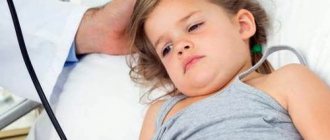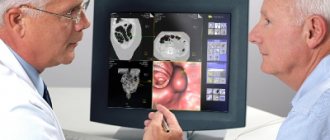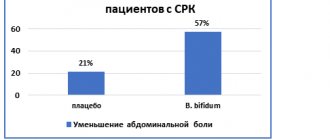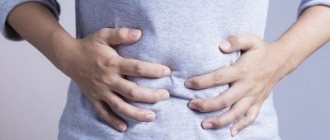How to treat irritable bowel syndrome in children: symptoms, treatment, diet - MEDSI
Table of contents
- Characteristics of the disease
- Causes
- Classification
- Symptoms and signs
- Complications and consequences
- Diagnostics and tests
- Treatment
- Forecast
- Prevention measures
- Advantages of the procedure at MEDSI
Irritable bowel syndrome (IBS) is the general name for functional disorders of the gastrointestinal tract not caused by organ pathology. It occurs in adults and children; about 30% of people on the planet are affected.
Characteristics of the disease
IBS refers to digestive disorders in the large intestine, associated changes in peristalsis and evacuation of processed food. The disease is often chronic, but is benign and can be easily corrected with diet and a healthy lifestyle.
Causes
- Disturbances of intestinal microflora (bacterial balance): early transfer of the child to artificial feeding, antibacterial therapy
- Features of the nervous system (vegetative-vascular dystonia, frequent stress)
- Disturbances in diet and routine (snacks, overeating, physical inactivity, insufficient sleep)
- Unbalanced diet (lack of dietary fiber, fiber)
- Genetic predisposition
- Endocrine diseases
- Infections (various colitis), parasites
Thus, treatment of irritable bowel syndrome in children will be directed against the cause that caused it.
Classification
- IBS with a predominance of diarrhea - frequent bowel movements, shapeless or loose stools with the slightest disturbance in nutrition, routine, change of environment, excitement (“bear disease”)
- With a predominance of constipation - children spend a long time in the toilet, there may be no stool for several days, the feces are hard (“sheep feces”)
- With a predominance of flatulence - the child is often bothered by spastic pain in the lower abdomen, a feeling of fullness, bloating, and frequent passing of gas
Symptoms and signs
- Spasms of intestinal smooth muscles with pain in the lower abdomen (right or left), discomfort when pressing on the abdomen; at night (during sleep) the pain disappears
- Tympanitis (drumming sound) over areas of gas accumulation
- Pain in the hypochondrium on the right, radiating to the shoulder blade and neck
- Dyspeptic syndrome (nausea, belching, early satiety)
- Mucus in stool
Treatment of irritable bowel syndrome in a child will necessarily include symptomatic therapy.
Complications and consequences
If, if a child has irritable bowel syndrome, treatment is not completed, the disease becomes chronic. In adulthood, complications such as:
- Hemorrhoids, rectal fissures
- Intestinal obstruction
- Absorption disorders (vitaminosis, anemia, metabolic disorder)
- Diseases of the upper gastrointestinal tract (duodenitis, gastritis)
Diagnostics and tests
Considering the similarity of IBS to other diseases of the gastrointestinal tract and the possibility of complications, it is recommended to conduct an examination of the child, which will include:
- Stool examination (bacterial) for dysbacteriosis and coprogram (stool composition)
- General clinical analysis of urine and blood
- Biochemical blood test (for protein, enzymes, electrolytes)
- Abdominal ultrasound (liver, gallbladder, spleen and pancreas)
- FGDS (examination of the stomach and duodenum)
- Colonoscopy (examination of the large intestine using an endoscope)
Treatment
When irritable bowel syndrome is established, children are treated in three areas:
- Eliminating the cause
- Eliminating symptoms
- Correction of regime and nutrition
Children are prescribed mild sedatives, parents are advised to put less stress on their children with studies, avoid stress at home, create a daily routine, monitor sleep (at least 9 hours a day), walks (at least 2 hours a day), physical activity (abs, swimming) .
To relieve pain, antispasmodics are prescribed, and prokinetics are prescribed to improve peristalsis (intestinal movements).
For dysbacteriosis - probiotics (beneficial bacteria, fermented milk products).
Forecast
The course of the disease and prognosis are favorable: timely medical intervention and follow-up with a pediatric gastroenterologist will help avoid consequences in adulthood - as a rule, if medical recommendations are followed, IBS symptoms disappear after puberty.
Prevention measures
To prevent functional digestive disorders in children, especially those prone to IBS, you need to:
- Continue breastfeeding for as long as possible, and later carefully monitor your diet
- Maintain a sleep schedule
- Provide adequate time for walking
- Create a calm, friendly atmosphere in the family
- Take infectious and parasitic diseases seriously, maintain personal hygiene, and consult doctors promptly
Advantages of the procedure at MEDSI
- Sensitive doctors: consultations are conducted by experienced pediatric gastroenterologists
- Availability of modern equipment: pediatric endoscopy (FGDS, colonoscopy), including endoscopy in a dream with recording on disk or flash
- Children's diagnosticians
- Own laboratory that performs a wide range of clinical, biochemical, bacteriological studies
- To make an appointment, call 8 (495) 7-800-500 (open 24 hours a day)
- Possibility of visiting a specialist after receiving results in the same place, discounts on repeat appointments
Digestive tract diseases
Recently, there has been an increase in the pathology of the digestive organs in children as a result of the influence of many factors:
- poor ecology, closely related to the widespread spread of viral, bacterial, and parasitic infections;
- unbalanced diet, consumption of foods containing preservatives and dyes, limited consumption of dietary fiber, great harm is caused by the so-called “fast food” that children love so much - carbonated and chilled drinks;
- increase in allergic reactions;
- increasing role of neuropsychic factors;
- neuroses and neurocircular dysfunctions;
- heredity (detected in 90% of cases of chronic digestive pathologies in children).
Pediatric gastroenterologists identify two main age peaks for gastrointestinal pathologies in children: 5-6 years and 9-11 years. Treatment of gastrointestinal diseases in children should be carried out only by a pediatric gastroenterologist. The main diseases of the digestive system in children are the following.
Diarrhea (diarrhea)
A consequence of impaired absorption of various nutrients due to decreased activity of digestive enzymes. The cause of diarrhea can be either artificial feeding, poor diet, or infectious and inflammatory processes in the intestines. Acute, prolonged diarrhea can lead to severe dehydration in a child.
Constipation
Chronic delay in bowel movement, lasting more than 2 days. The causes of constipation can be: violation of the diet and balance, incorrect anatomical structure of the large intestine, side effects of medications, psychological problems. Prolonged constipation in a child can lead to weakness, loss of appetite, pallor, headaches, allergic reactions, and pustular skin lesions.
Chronic gastritis
Chronic inflammation of the gastric mucosa. In children, chronic gastritis is usually combined with damage to the duodenum, biliary tract, and pancreas. Often occurs due to eating disorders. The presence of Helicobacter pylori in the body plays a significant role. The main symptoms are pain in the epigastric region either on an empty stomach or 1.5-2 hours after eating, heartburn, belching of air or sour, nausea, constipation or diarrhea. The tongue is coated and there may be bad breath.
Acute gastritis
Acute inflammation of the gastric mucosa. Occurs as a result of ingestion of food containing pathogenic bacteria, or in violation of the dietary regime (large amounts of rough food, unripe vegetables and fruits, etc.). May be accompanied by increased body temperature, nausea, weakness, vomiting, cramping abdominal pain, and bloating.
Acute gastroenteritis
Inflammatory disease of the stomach and small intestine. The reasons are the same as for acute gastritis. Symptoms: increased body temperature, vomiting, lack of appetite, pain throughout the abdomen, rumbling, bloating, diarrhea. Peptic ulcer of the stomach and duodenum. It is observed mainly in school-age children. The disease most often has a hereditary nature, and is also associated with the characteristics of the nervous system (increased excitability, reaction to stress). Characterized by severe long-term pain in the epigastrium and navel area, occurring 2-4 hours after eating, at night, or “hunger pain” on an empty stomach, sometimes radiating to the lower back, right shoulder, and shoulder blade. Nausea, vomiting, heartburn, and belching are noted. The course in children is often protracted, with relapses. Helicobacter pylori plays an important role in the development of peptic ulcer disease.
Chronic duodenitis
Chronic inflammation of the duodenum. In children, it most often occurs against the background of chronic gastritis, peptic ulcer, and biliary tract pathology. Characterized by aching pain in the upper abdomen, nausea, heartburn, and belching.
Chronic enterocolitis
An inflammatory disease of both the large and small intestines (enteritis - inflammation of the small intestine, colitis - inflammation of the large intestine). Occurs, as a rule, after acute infectious gastrointestinal diseases. Characterized by frequent painful or unstable bowel movements, flatulence, cramps, pain, general weakness, and lack of appetite.
Biliary dyskinesia
Children are characterized by a combination of damage to the biliary tract and gastroduodenal zone. The disease is characterized by pain in the liver and gall bladder, bitterness in the mouth, and sometimes vomiting.
Chronic and acute hepatitis
Inflammatory liver diseases lasting more than 6 months (chronic form) and up to 6 months (acute hepatitis). The main reason is viral infection (hepatitis viruses, cytomegalovirus), congenital and hereditary diseases, toxic liver damage. Most often, children complain of pain or heaviness in the right hypochondrium, weakness, and loss of appetite. Sometimes there is a icteric discoloration of the sclera and skin, nausea, and unstable stool. He is being treated in a hospital.
Chronic cholecystitis (cholecystocholangitis)
Chronic inflammatory disease of the biliary tract, which affects children of preschool and school age. Caused by infection (Escherichia coli, streptococci, staphylococci, enterococcus, etc.), or as a complication after hepatitis, enterovirus infection. The main symptom is pain in the right hypochondrium, in the navel area, nausea, vomiting, increased body temperature. Chronic pancreatitis. Chronic inflammation of the pancreas. Characterized by intense pain in the epigastrium, in the left hypochondrium, sometimes throughout the entire abdomen, radiating to the lower back, back, and left arm. The child experiences aversion to food, nausea, repeated vomiting, flatulence, constipation or loose stools.
This is not a complete list of diseases of the digestive system in children. Treatment and drug therapy should be prescribed only by a pediatric gastroenterologist and strictly correspond to the diagnosis given by him.
Course of duodenitis
Under the influence of any external or internal factors, the mucous membrane becomes inflamed. As a result, the process of its regeneration is disrupted, and the tissue gradually atrophies. In the chronic form of the disease, tissues are constantly damaged, active oxygen accumulates, and infiltrates are formed. The body's defenses cannot cope with the abundance of active oxygen, the mucous membrane is continuously damaged, as oxidative processes constantly occur. As a result, the tone of the duodenum and stomach increases, and the motility of these organs is disrupted. Source: M.N. Repetskaya, O.M. Burdina Modern features of the course of chronic gastroduodenitis in children // Perm Medical Journal, vol. XXXIV, No. 3, 2017
Treatment of duodenitis in children
This disease needs to be treated comprehensively . A sick child should be isolated from stress, provided with physical rest, physical therapy, and medications prescribed by a doctor. Proper diet is extremely important:
- exclusion of foods that increase bile secretion (fats, fried foods, confectionery, egg yolks, etc.);
- preparing a diet taking into account stool disorders and stomach acidity;
- fractional meals;
- breaks between meals – no more than 4 hours;
- sufficient amount of liquid;
- avoiding foods that are too cold or hot;
- excluding carbonated drinks.
In case of exacerbation of the chronic form, the child must observe strict bed rest for 3 to 7 days until symptoms decrease. Source: M.Yu. Denisov Practical gastroenterology for pediatricians: reference book. manual // M.: Publisher Mokeev, 2000. 296 p.
Treatment usually takes place at home, but if the child’s condition is severe, hospitalization is required.
General recommendations:
- after eating, lie down for two hours;
- sleep at least eight hours a day;
- exclude physical activity that can sharply increase intra-abdominal pressure (strength sports, running, jumping).
During periods of remission, children are often sent to dispensaries or sanatoriums.
Intestinal infection in children
Symptoms of intestinal infection in children
The manifestations of intestinal infections are generally similar, but may differ depending on the pathogen.
Viral ones develop and pass faster; general and local manifestations are typical for them. Rotavirus infection is characterized by an acute onset within a few hours or 1-2 days after contact with sick people. Typically, the temperature rises to 38-39ºС, the occurrence of cramping or constant pain in the abdomen. In addition, nausea and frequent vomiting occur, and diarrhea occurs up to 10 or more times a day. The stool is liquid, foamy, slightly colored, watery. Also typical is loss of appetite and severe weakness, pallor, and drowsiness. In addition, catarrhal symptoms are possible - runny nose, sore throat, signs of conjunctivitis.
Adenoviral gastroenteritis is also called intestinal flu. Among the key manifestations are nausea and rare vomiting, pain in the abdomen, the appearance of loose stools with a greenish tint, bloating, rumbling in the abdomen, dry tongue, and the appearance of a white coating on it. It is also typical for the temperature to rise to 38ºC or higher, which will last up to 3-4 days. In addition, conjunctivitis and runny nose are possible.
Enteroviral infections are a large group of viruses; children are most often infected with the Coxsackie and ECHO types. The disease begins with acute manifestations, an increase in temperature, which fluctuates greatly throughout the day. Appetite decreases, weakness, nausea with vomiting, diarrhea and headache occur. Signs of a cold may also appear. With enterovirus, symptoms may fade and return again in waves.
A bacterial intestinal infection, for example, dysentery (shigellosis), begins with the appearance of cramping abdominal pain localized in the left iliac region and loose, scanty stool. By the end of the day, the stool becomes specific - a mixture of mucus and pus mixed with blood (rectal spit). By 2-3 days, the symptoms will be maximum, the temperature rises, pain develops in the left side of the abdomen, and excruciating nagging pain and tenesmus (false painful urge to defecate) are characteristic. The tongue is covered with a brown coating, the skin is pale and dry.
With salmonellosis, pain in the upper abdomen, diarrhea, sometimes with an admixture of mucus, greens (“swamp mud”), blood (hemocolitis) and vomiting against the background of severe intoxication and high temperature are typical, damage to the cardiovascular system is typical: weakened pulse, decreased blood pressure . Usually the disease takes the form of outbreaks in a family or children's group; several people become ill at once.








